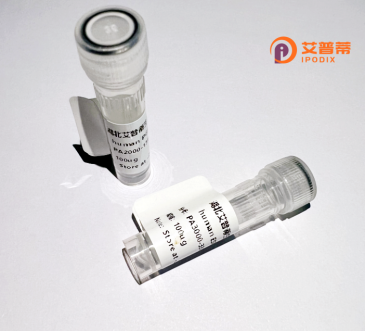
| 纯度 | >90%SDS-PAGE. |
| 种属 | Human |
| 靶点 | SLC23A1 |
| Uniprot No | Q9UHI7 |
| 内毒素 | < 0.01EU/μg |
| 表达宿主 | E.coli |
| 表达区间 | 1-259 aa |
| 活性数据 | MRAQEDLEGRTQHETTRDPSTPLPTEPKFDMLYKIEDVPPWYLCILLGFQHYLTCFSGTIAVPFLLAEALCVGHDQHMVSQLIGTIFTCVGMFCTLFGMITAVGLSNLQFVDMNSSRNLFALGFSMFFGLTLPNYLESNPGAINTGILEVDQILIVLLTTEMFVGGCLAFILDNTVPGSPEERGLIQWKAGAHANSDMSSSLKSYDFPIGMGIVKRITFLRYIPICPVFKGFSSSSKDQIAIPEDTPENTETASVCTKV |
| 分子量 | 54.23 kDa |
| 蛋白标签 | GST-tag at N-terminal |
| 缓冲液 | PBS, pH7.4, containing 0.01% SKL, 1mM DTT, 5% Trehalose and Proclin300. |
| 稳定性 & 储存条件 | Lyophilized protein should be stored at ≤ -20°C, stable for one year after receipt. Reconstituted protein solution can be stored at 2-8°C for 2-7 days. Aliquots of reconstituted samples are stable at ≤ -20°C for 3 months. |
| 复溶 | Always centrifuge tubes before opening.Do not mix by vortex or pipetting. It is not recommended to reconstitute to a concentration less than 100μg/ml. Dissolve the lyophilized protein in distilled water. Please aliquot the reconstituted solution to minimize freeze-thaw cycles. |
以下是关于重组人SLC23A1(SVCT1)蛋白的3篇关键文献摘要:
---
1. **文献名称**: *The role of sodium-dependent vitamin C transporter (SVCT1) in intestinal ascorbic acid absorption*
**作者**: Lutsenko et al. (2008)
**摘要**: 研究揭示了SLC23A1(SVCT1)在小肠中介导维生素C主动吸收的机制,发现其表达水平与膳食抗坏血酸的摄入效率直接相关,为理解维生素C缺乏症提供分子基础。
2. **文献名称**: *Functional characterization of human sodium-dependent vitamin C transporters (hSVCT1 and hSVCT2) in mammalian cells*
**作者**: Wang et al. (2003)
**摘要**: 通过体外表达系统分析SLC23A1的转运动力学,证实其对维生素C的高亲和力及钠离子依赖性,并发现其结构特异性(如跨膜域突变)会显著降低转运活性。
3. **文献名称**: *Epigenetic regulation of the human sodium-dependent vitamin C transporter (SLC23A1) by DNA methylation in diabetes*
**作者**: Maulén et al. (2015)
**摘要**: 该研究报道糖尿病患者的SLC23A1启动子区域存在DNA甲基化异常,导致其在肾脏中的表达下调,可能与糖尿病并发症中维生素C代谢紊乱相关。
---
以上研究覆盖了SLC23A1的生理功能、结构-活性关系及疾病关联机制。如需具体期刊或补充文献,可进一步提供关键词或研究领域细化检索。
The solute carrier family 23 member 1 (SLC23A1), also known as sodium-dependent vitamin C transporter 1 (SVCT1), is a key protein involved in the cellular uptake of vitamin C (ascorbic acid). Belonging to the SLC transporter superfamily, SVCT1 mediates sodium-dependent transport of ascorbate, essential for maintaining vitamin C homeostasis in humans. It is primarily expressed in epithelial tissues, including the intestines and kidneys, where it facilitates dietary absorption and renal reabsorption of ascorbate, respectively. Vitamin C, a critical antioxidant and cofactor in enzymatic reactions (e.g., collagen synthesis), relies on SVCT1 for efficient cellular uptake, particularly in tissues with high metabolic demands.
Mutations or dysregulation in SLC23A1 have been linked to altered plasma vitamin C levels and potential associations with chronic diseases, such as cardiovascular disorders and cancer. Recombinant human SLC23A1 protein is produced via heterologous expression systems (e.g., mammalian cells or bacteria) for functional studies, enabling researchers to investigate transport kinetics, substrate specificity, and drug interactions. Its applications extend to drug development targeting vitamin C metabolism, as well as modeling pathological conditions related to ascorbate deficiency or transporter dysfunction. This recombinant tool enhances understanding of SLC23A1's role in physiology and disease, offering insights for therapeutic strategies.
×